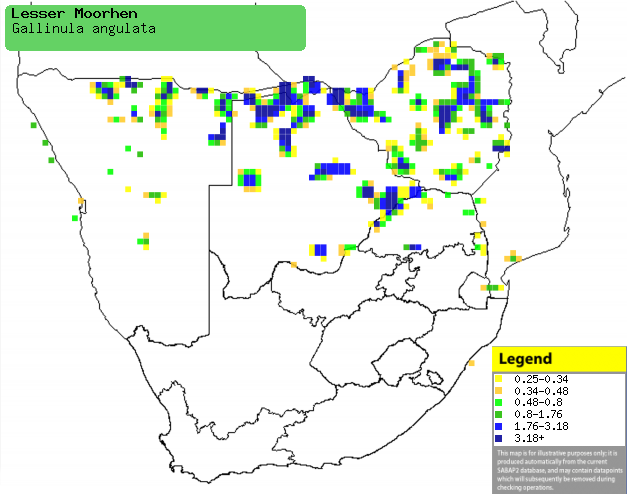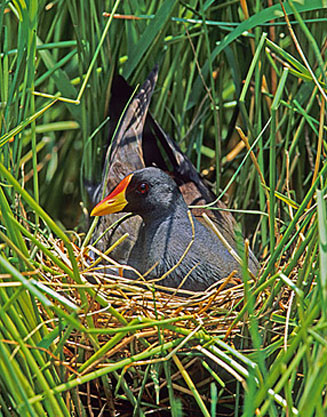|
Gallinula angulata (Lesser moorhen)
Kleinwaterhoender [Afrikaans]; Edenene (generic term for gallinules and
moorhens) [Kwangali]; Nhapata (generic name for coot, gallinule, moorhen,
crake or rail) [Shona]; Kukumezani (generic name for moorhen or coot)
[Tsonga]; Afrikaans waterhoen [Dutch]; Gallinule africaine [French];
Zwergteichhuhn [German]; Galinha-d'įgua-pequena [Portuguese]
Life
> Eukaryotes >
Opisthokonta
> Metazoa (animals) >
Bilateria >
Deuterostomia > Chordata >
Craniata > Vertebrata (vertebrates) > Gnathostomata (jawed
vertebrates) > Teleostomi (teleost fish) > Osteichthyes (bony fish) > Class:
Sarcopterygii (lobe-finned
fish) > Stegocephalia (terrestrial
vertebrates) > Tetrapoda
(four-legged vertebrates) > Reptiliomorpha > Amniota >
Reptilia (reptiles) >
Romeriida > Diapsida > Archosauromorpha > Archosauria >
Dinosauria
(dinosaurs) > Saurischia > Theropoda (bipedal predatory dinosaurs) >
Coelurosauria > Maniraptora > Aves
(birds) >
Order: Gruiformes > Family: Rallidae
Distribution and habitat
Occurs sub-Saharan Africa; in southern Africa it is locally common in northern Namibia (including the Caprivi Strip),
northern and eastern Botswana, Zimbabwe and north-eastern South Africa. It
generally prefers freshwater wetlands such as swamps, marshes, ponds, sewage
ponds and seasonally inundated grassland and flood plains.
|
 |
|
Distribution of Lesser moorhen in southern Africa,
based on statistical smoothing of the records from first SA Bird Atlas
Project (©
Animal Demography unit, University of
Cape Town; smoothing by Birgit Erni and Francesca Little). Colours range
from dark blue (most common) through to yellow (least common).
See here for the latest distribution
from the SABAP2. |
Movements and migrations
Intra-African breeding migrant, breeding in
southern Africa and adjacent countries in the period from
November-May, mainly December-April.
Food
Mainly eats insects, seeds and flowers of reeds and
molluscs, doing most of its foraging along the water's edge, plucking prey from
the mud and vegetation.
Breeding
- Monogamous territorial solitary nester, arriving at its breeding grounds
soon after floods.
- The nest (see image below) is a shallow grass cup on a a platform of
bent live grass or sedge stems, flimsy at first but becoming progressively
stronger as more material is added.
 |
|
|
Lesser moorhen at its nest, Sericea farm,
South Africa. [photo Warwick Tarboton ©] |
|
- Egg-laying season is from November-March, peaking from January-February.
- It lays 4-9 eggs, which are mainly incubated by the female for about
19-20 days.
- The chicks take their first flight at about 35-38 days old, becoming
fully independent roughly 5-6 weeks later.
Threats
Not threatened.
References
-
Hockey PAR, Dean WRJ and Ryan PG 2005. Roberts
- Birds of southern Africa, VIIth ed. The Trustees of the John Voelcker
Bird Book Fund, Cape Town.
|
